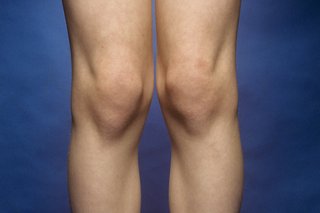How Do You Know if You Have Valgus Deformity Knee
A person with knock knees (genu valgum) has a big gap between their feet when they're standing with their knees together.
Many young children have knock knees, which tend to be about obvious at around the age of 4.
It's almost e'er merely a normal part of their evolution, and their legs volition commonly straighten by the age of 6 or 7.
Slight knock knees can go along into adulthood, but this also isn't unremarkably anything to worry near unless it causes other bug.
Nonetheless, knock knees can very occasionally exist a sign of an underlying condition that needs treatment, especially if the status develops in older children or adults, or doesn't improve with age.
Symptoms of knock knees
If someone with knock knees stands with their knees together, their lower legs volition be spread out and so their anxiety and ankles are further apart than normal.

A minor altitude between the ankles is normal, but in people with knock knees this gap tin can be up to 8cm (just over 3 inches) or more.
Knock knees don't unremarkably cause any other issues, although a few severe cases may cause knee pain, a limp or difficulty walking.
Knock knees that don't improve on their own tin can besides identify your knees under extra pressure, which may increase your adventure of developing arthritis.
When to get medical advice
Knock knees in children aren't usually a cause for concern and should improve equally your child gets older.
However, visit your GP if:
- the gap betwixt the ankles is greater than 8cm while continuing with the knees together
- there's a big difference betwixt the bending of the lower legs when standing compared with the upper legs
- the trouble seems to be getting worse
- a kid nether the age of 2 or over the age of seven has knock knees
- just one leg is affected
- there are other symptoms, such as knee hurting or difficulty walking
- you have any other concerns most the way your child stands or walks
- you develop knock knees in adulthood
Your GP will examine your or your child's legs, enquire about any hurting or walking difficulties, and may have some measurements.
They may refer you to an orthopaedic surgeon (a specialist in bone and articulation problems) and arrange an X-ray of your legs and claret tests to check for underlying bug.
What causes knock knees?
Knock knees are fairly common in good for you children under the ages of half-dozen or seven, and are just a normal role of growth and evolution.
The legs will unremarkably gradually straighten as the child grows, although balmy knock knees can concluding into adulthood.
Knock knees that develop later in childhood or don't improve with age tin sometimes be associated with an underlying problem, such every bit:
- rickets – bug with bone development resulting from a lack of vitamin D and calcium
- excessive pressure on the knees – for example, as a consequence of obesity or loose human knee ligaments (the bands of tissue effectually joints that connect basic to i another)
- an injury or infection affecting the knees or leg bones
- genetic conditions affecting the evolution of the bones or joints
Adults can sometimes develop knock knees. These cases are often associated with joint issues such as osteoarthritis or rheumatoid arthritis.
Treatments for knock knees
In nearly cases, knock knees don't need to exist treated because the problem tends to right itself as a kid grows.
Your child doesn't need to avoid physical action, wear supportive leg braces or shoes, or do whatever special exercises.
Mild knock knees that persist into adulthood don't need to be treated unless they're causing problems, such as knee pain.
Treating the underlying cause
If knock knees are acquired past an underlying condition, treatment for this may be necessary. For instance, rickets can be treated with vitamin D and calcium supplements.
Read more about treating rickets.
Adults with arthritis may benefit from wearing leg braces or special insoles to reduce the strain on their knees.
Read more than virtually treating osteoarthritis and treating rheumatoid arthritis.
Surgery
Surgery for knock knees is rarely necessary, although it may be recommended if the condition is astringent or persistent.
At that place are two main types of operation that may be carried out:
- guided growth – where small metallic plates are placed on the inside of the knees, which helps correct their growth over a menses of around 12 months; the plates will exist removed in one case the treatment is complete
- an osteotomy – where a thin wedge of os is removed from the leg bones so they're realigned into the correct position; plates and screws are used to fix the bones in their new position
Children with persistent knock knees who are still rapidly growing are more likely to be offered the guided growth operation. Osteotomies are mainly used for adults with severe knock knees.
Both procedures are carried out under full general anaesthetic, which means yous or your kid will be unconscious while having the operation.
A child can usually start walking once again within a few days of having a guided growth procedure and return to sports within a few weeks. Information technology can take a few months to render to all your normal activities after having an osteotomy.
Page last reviewed: 19 November 2018
Next review due: 19 Nov 2021
andersonwelverepose.blogspot.com
Source: https://www.nhs.uk/conditions/knock-knees/
Post a Comment for "How Do You Know if You Have Valgus Deformity Knee"